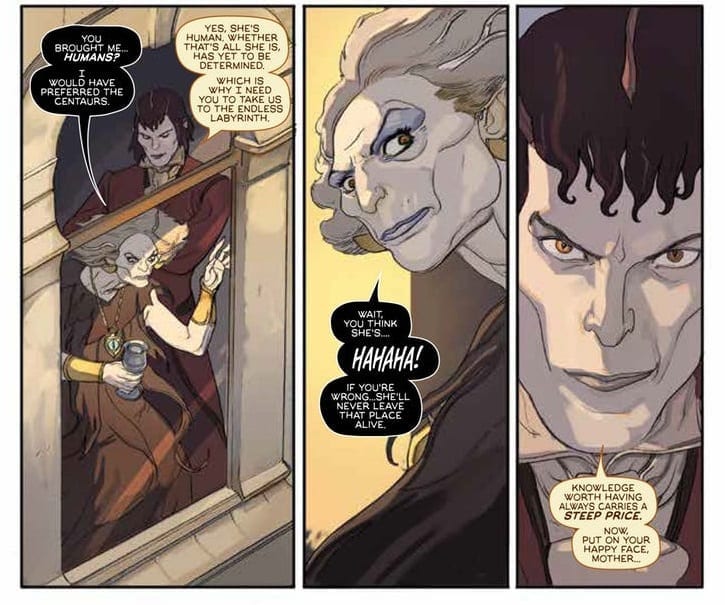The stage is set; the characters have taken their places; and all await the unravelling of Oberon’s plan. The second issue of AfterShock Comics fantasy adventure leaves the mortal world behind and takes the reader into a magical land.
Brimming with character and adventure, this second issue faces the difficult challenge of transitioning totally from the real world into the imagined.
Writing/Story
Bonnie is still reeling from the news that she is adopted and waking up in the tree house of a Fairy King simply adds to her culture shock. Luckily Nicholas Walker, man servant, is on hand to dispense food and a touch of wisdom.
And then Oberon himself makes his grand entrance, ready for the adventure ahead.
Ryan Parrott writes his characters as if they are from a lavish stage production: all but Bonnie that is. This approach is perfect for a tale of this nature as it has all the hall markings of a Sandman comic and revels in the performance of each character.
In contrast Bonnie is written with a down to Earth attitude and almost a resistance to the magical elements that she is faced with. The stark difference between the central characters are apparent on each page. Oberon is larger than life and every time he speaks you get the impression his voice fills the room he is in. Bonnie on the other hand is small in size and stature. She is often depicted smaller than the other characters, viewed from above or it is shown that others have to physically come down to her level.
This contrast in presence is Parrott’s way of reminding the reader who is, currently, in charge of the situation. Many schemes and plots are in process, some of which still aren’t known to the reader, but Oberon is in charge of them all. Bonnie is a lost girl looking for guidance, in the same way as the reader is.
Parrott fills the plot with an array of mysteries and intrigues, drawing inspiration from the old Shakespearean tradition. As this second act unfolds, the writer is not afraid to introduce many more characters and plot threads. It may take some readers a second read through to pick up on all of the comings and goings but the poetic writing makes this a pleasure not a chore.

Art
One element of the comic that every reader will revisit before reaching the end of the issue is Bonnie’s journey into the maze. This forms an important part of the narrative but there is a wonderful trick that the artist employs to enhance the difficulty that Bonnie has.
This sequence, like much of the comic, is a call back to another famous fantasy; in this case Labyrinth. The setup is slightly different but the early onset of frustration that Bonnie feels is the same as the one Sarah feels in that movie. The way that Milos Slavkovic handles it is simply wonderful and you may not even notice it at first.
The rest of the comic shows off Slavkovic’s creative brilliance and attention to detail. Whereas the first issue was very grounded in reality, for the most part, the artist has really let his imagination flow for this second issue. Oberon’s world is full of wonder and spectacle. Slavkovic also manages to cram in a large number of ominous omens which mirror Oberon’s double dealings. Images of skulls and imprisonment are subtly, and not so subtly, entwined into the fabric of the world building.
Taking a lead from Parrott’s flamboyant central character, Slavkovic has produced an over the top, theatrical stage for Oberon’s story to be told. In other comics this would be too much but here, his style is spot on.
The letter, Charles Pritchett, adds another layer of theatrics to the show. His speech balloons give the characters’ voice emphasis with additional support by the bolding of text. The script becomes a performance in Pritchett’s lettering style so much so that it’s difficult not to read each character in a different voice. This is especially true in the conversation between Oberon and Mother Mayie. The contrast between them is brought to life by the opposing speech balloons. A lot of the characterisation of these two is brought out through their speech, which is as it should be for a theatrical piece like this.

Conclusion
The story relies heavily on familiar themes and references, something which may put people off. However, Parrott and co are not doing anything that Neil Gaiman didn’t do when plundering older literature for his Sandman comics. The characters and situations may seem familiar but it is the way that they are made different that marks Oberon out as an enjoyable read. Noticing the differences is part of the game.
The art work is superb with close attention to detail and emotion. It is comical in places and stomach turning in others. The only time there is a drop in art standards is when there is fast action. Here the characters are stilted, more amateur dramatics than Royal Shakespeare Company. However, this does not mar the rest of the comic, and these moments are kept to a minimal. It’s just not that type of comic.
Oberon is enjoyable, clever and deliberately over the top. It is well on its way to becoming a fantasy series worth watching for.

